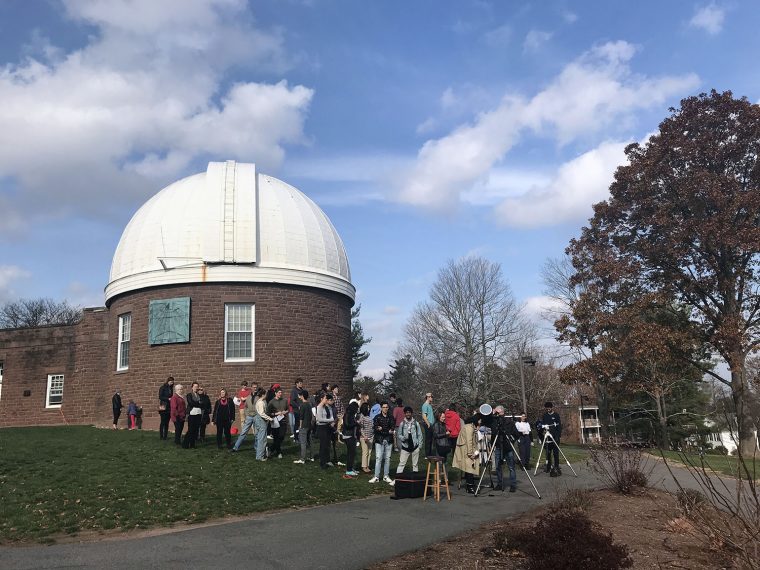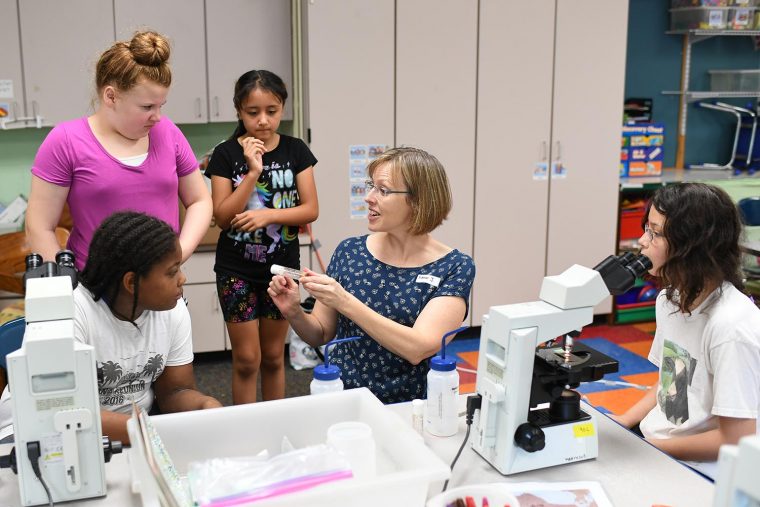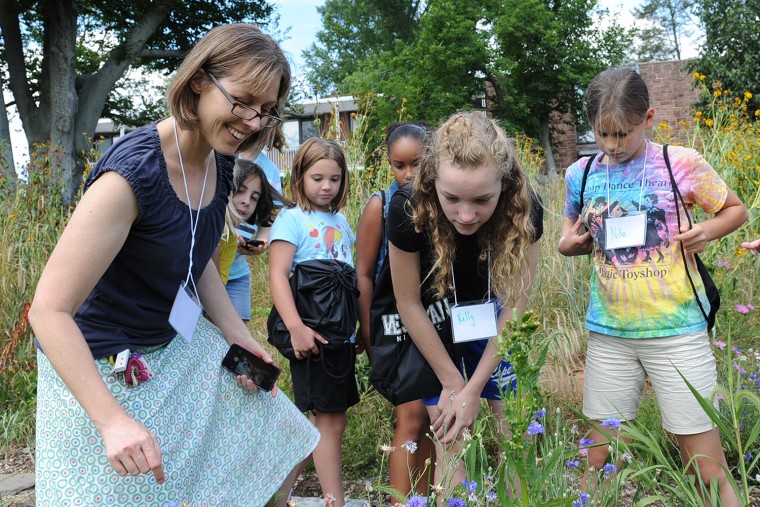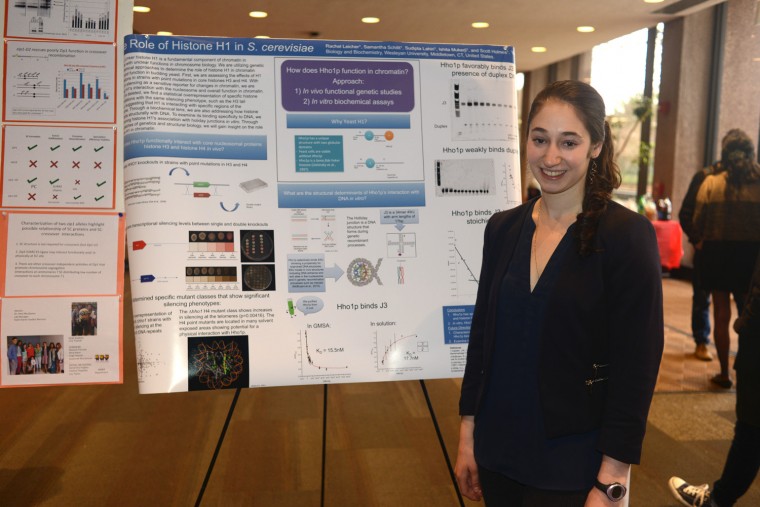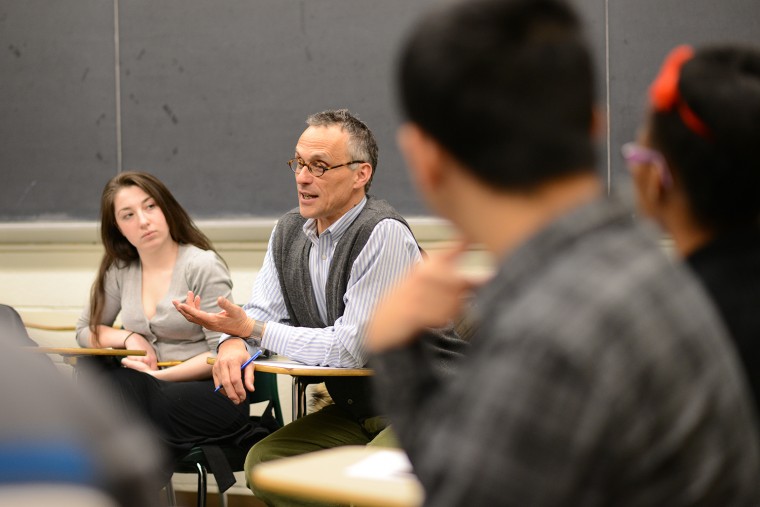For only the seventh time since Wesleyan’s founding, the planet Mercury passed directly in front of the sun, from the perspective of Earth—and Wesleyan served as a gathering place from which to learn about and observe the event. Faculty and students from Wesleyan’s astronomy department, as well as others from the University and the greater Middletown community, gathered outside the Van Vleck Observatory on Nov. 11 to witness the transit through three telescopes. The mild weather and partly cloudy conditions—particularly at the beginning and end of the transit (which lasted from 7:35 a.m. to 1:04 p.m.)—made for good viewings through…
Four girls squint one eye and with the other eye gaze intently into a microscope. One says she sees caterpillars or string or pink spaghetti. Another says she sees small frogs. "You're actually looking at tissue that's been smashed," says Ruth Johnson, associate professor of biology. "Do you see those dark spots? Those are chromosomes." Johnson, a developmental biologist who studies how tissues and organs are shaped during development, is one of five Wesleyan faculty who taught workshops during the fifth annual Girls in Science Summer Camp, Aug. 6–10. The camp is open to all girls in grades 4, 5, and…
This summer, Wesleyan hosted the second annual Wesleyan Scientific Imaging Contest, which recognizes student-submitted images from experiments or simulations done with a Wesleyan faculty member that are scientifically intriguing as well as aesthetically pleasing. This year, 33 images were submitted from six departments. The entries were judged based on the quality of the image and the explanation of the underlying science. The images were judged by a panel of four faculty members: Steven Devoto, professor of biology, professor of neuroscience and behavior; Ruth Johnson, assistant professor of biology, assistant professor of integrative sciences; Brian Northrop, assistant professor of chemistry, assistant professor of…
The Green Street Teaching and Learning Center hosted a Girls in Science Camp Aug. 3-7. Wesleyan faculty members Ruth Johnson, assistant professor of biology (pictured third from left); Erika Taylor, assistant professor of chemistry, assistant professor of environmental studies (pictured at far right); Chris Othon, assistant professor of physics (pictured at left), along with three undergraduate students, worked with the campers on various experiments. Sara MacSorley, director of the GSTLC (second from left), coordinated the activities. Johnson led the campers on a bug hunt through Wesleyan's West College Courtyard garden. There, the girls observed insects while considering insect diets and insect life-cycles. The girls…
#THISISWHY On April 17, 30 senior and BA/MA students in the Natural Sciences and Mathematics Division presented their research to the Wesleyan community. Nearly 100 people attended the annual Celebration of Science Theses poster session, which was held in the Exley Science Center lobby. The event was co-organized by Manju Hingorani, professor of molecular biology and biochemistry; Barbara Juhasz, associate professor of psychology, associate professor of neuroscience and behavior, director of the service learning center; and Seth Redfield, assistant professor of astronomy. (Photos by Dat Vu '15.) (more…)
(more…)
Becker says a killer rhubarb pie is to thank for starting her biology career at Wesleyan
Maya Gomes ’06 and her co-author Matthew Hurtgen published their paper, “Sulfur isotope systematics in a permanently euxinic, low-sulfate lake: Evaluating the importance of the reservoir effect in modern and ancient oceans,” in the June issue of the journal, Geology. In the paper, the authors present data that shows how geologists can use sulfur isotope compositions of marine sediments to discover variations in oceanic sulfate levels through Earth history. Gomes explained that the paper is very important to researchers who study the climate of the past because “marine sulfate levels play a role in regulating oxygen and carbon dioxide levels…
Best-selling author Mary Roach 81 has just published her latest gift to readers, Gulp: Adventures on the Alimentary Canal (W. W. Norton), in which she takes a memorable tour inside and outside of the body. Her fascinating book on the process of eating brings readers upclose with the bodily equipment that turns food into the nutrients and sustenance that keeps us ticking. On her quest for knowledge of the digestive tract, Roach meets with professors and technicians, murderers, mad scientists, Eskimos, exorcists, rabbis and other unique characters. She is fearless in asking taboo and embarrassing questions with relish and humor.…
(more…)
Peder Zane ’84 has co-written a new book Design in Nature (Doubleday) with Professor Adrian Bejan of Duke University, which describes Bejan’s groundbreaking discovery, the constructal law, a principle of physics that governs all design and evolution in nature. The constructal law holds that all shape and structure emerges to facilitate flow. Rain drops, for example, coalesce and move together, generating rivulets, streams, and the mighty river basins of the world because this design allows them to move more easily. The question to ask is: Why does design arise at all? Why can't the water just seep through the ground?…


